#Sumatran rhinoceros
Explore tagged Tumblr posts
Text
Video footage of Sumatran rhinoceros "Delilah", granddaughter of the Cincinnati Zoo's "Emi" and "Ipuh", alongside her calf. The little male was born on November 25th, 2023, at the Sumatran Rhino Sanctuary in Way Kambas National Park. There are likely no more than 50 Sumatran rhinos left in the wild, and only 11 in captivity.
#Sumatran rhinoceros#Sumatran rhino#Conservation#Mammal#CR#Video#Live specimen#Captive#Upload#Delilah
376 notes
·
View notes
Text
Some good news from Indonesia: the Sumatran Rhino Sanctuary in Way Kambas National Park has just announced that on November 25th their female Sumatran Rhino named Delilah gave birth to a healthy male calf!!!

(Photo credit: Indonesian Ministry of Environment and Forestry)
The as of yet unnamed calf is the second calf born at the sanctuary this month, and his mother Delilah was the second calf ever born at the sanctuary as well as the first captive bred Sumatran rhino to successfully give birth in captivity, so this is great news for captive breeding efforts of this species. There are only somewhere between 34 and 47 Sumatran rhinos in the wild, so captive breeding is incredibly important for this species survival. The sanctuary plans to eventually release the rhinos born at the sanctuary in order to help build the wild population back up. This baby is the fifth calf to be born at the sanctuary, and in addition to being Delilah’s first calf, he is also the first calf to be sired from his father, Harapan, who was originally born in the Cincinnati Zoo.
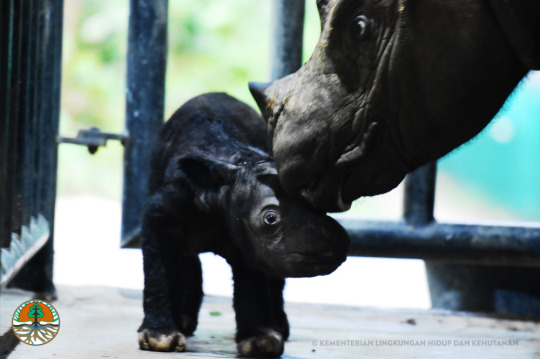
The mother and calf are currently being held in a naturalistic enclosure at the sanctuary (as the goal is to try to get them to live a life as similar to in the wild as possible) and are being heavily guarded to protect them from poachers. This species has suffered so much due to a combination of poaching for their horns as well as habitat loss. They are also pretty hard to keep and breed in captivity due to their shy nature, so this calf is amazing news!
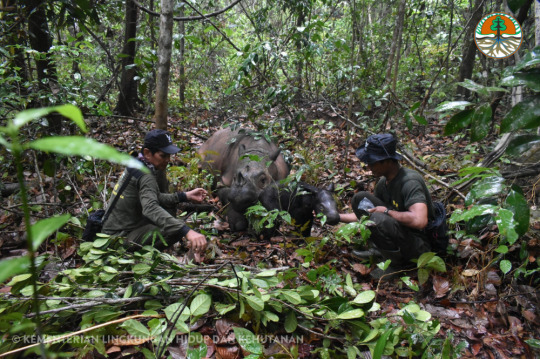
Also! Fun fact: this species of rhino is the closest living relative of the extinct Woolly Rhinoceros (Coelodonta antiquitatis). Which makes sense since the Sumatran rhino is the hairiest of all the living rhino species, which you can especially see with the babies.
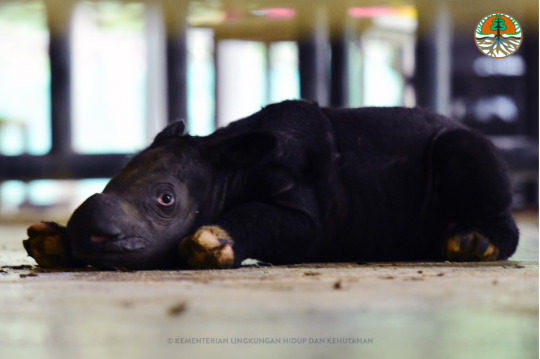
#indonesia#Indonesian wildlife#rhinoceros#sumatra#Sumatran rhinoceros#conservation#endangered species#good news#baby animals#baby rhino#wildlife#asian wildlife#animals#animal lover
357 notes
·
View notes
Text

An endangered female Sumatran rhinoceros, recently born at the Sumatran Rhino Sanctuary of Kambas national park, lays down in Lampung, Indonesia
Photograph: Antara Foto/Reuters
#antara foto#photographer#reuters#sumatran rhinoceros#rhino#rhinoceros#sumatran rhino sanctuary#kambas national park#lampung#indonesia#animal#mammal#nature
57 notes
·
View notes
Photo


Sumatran rhinoceros (Dicerorhinus sumatrensis) female eating leaves, Way Kambas National Park, Sumatra, Indonesia © Cyril Ruoso/Minden Pictures
Today on Bing- May 19, 2023 Sumatran rhinoceros, Way Kambas National Park, Indonesia
How can we help at-risk animals? | EN-CA, EN-CN, EN-GB
On the edge of extinction | EN-US
92 notes
·
View notes
Text
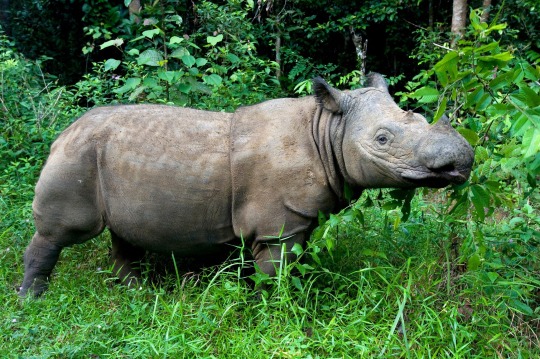
Sumatran rhinoceros (Dicerorhinus sumatrensis)
The smallest living species of rhino, the Sumatran rhinoceros has a thin layer of hair and a diet composed mostly of tree saplings. They used to live on the islands of Sumatra and Borneo, on the Malay Peninsula, and even as far north as India, in rainforest, tropical swamp, and highland forest environments. But like other rhinos, they have dwindled in the last few centuries, and there are less than 100 Sumatran rhinos living today. They leave behind a variety of physical traces- wallows in the ground to cool off in, scrapes in the ground and bent saplings to mark their territory, and paths carved through the brush.
#markhors-menagerie#animal facts#animals#biology#fun facts#ungulates#odd toed ungulates#rhinoceros#Sumatran rhinoceros
11 notes
·
View notes
Text

The #Sumatranrhinoceros (Dicerorhinus sumatrensis), also known as the Sumatran rhino, hairy rhinoceros or Asian two-horned rhinoceros, is a rare member of the family Rhinocerotidae and one of five extant species of rhinoceros; it is the
2 notes
·
View notes
Text

Sumatran rhinoceros stretching. I’m not good at drawing mammals so I’m trying to practice that a lot more.
7 notes
·
View notes
Text
Sumatran rhinoceros, Indonesia

As natural habitats shrink and disappear, thousands of species, like the Sumatran rhino pictured here, are at risk of extinction. Logging and hunting have led to their inclusion on the IUCN Red List of Critically Endangered Species, joining over 38,500 threatened species. Once plentiful across Southeast Asia, fewer than 100 Sumatran rhinos live in the wild today.
Governmental regulations and organisational measures have helped previously endangered species increase their numbers. Humpback whales, gray wolves, tigers and bald eagles have all seen significant population increases. Even with this encouraging progress, we must continue to take action through legislation, conservation, spreading awareness and personal habits.
2 notes
·
View notes
Text
How does one convince a Sumatran Rhino to play hide and seek in the rainforest?
The Sumatran rhinoceros (Dicerorhinus sumatrensis) is one of the most endangered large mammals in the world, with fewer than 80 individuals remaining in the wild. These magnificent creatures, native to the dense tropical forests of Indonesia and Malaysia, are known for their elusive nature and solitary habits. Imagining a Sumatran rhino playing hide and seek in the rainforest is a whimsical and…
#animal behavior#animal enrichment#animal training#animal welfare#anti-poaching#biodiversity#conservation awareness#conservation efforts#conservation initiatives#creative engagement#educational programs#endangered species#environmental outreach#ethical wildlife care#habitat preservation#hide and seek#natural behavior#playful learning#positive reinforcement#public involvement#rainforest#rhino conservation#rhino habitat#species protection#Sumatran rhino#Sumatran rhinoceros#tropical forests#wildlife conservation#wildlife education#wildlife preservation
0 notes
Text
This rhino 🦏 things escalated quickly



0 notes
Text

Hello! I'm so proud to finally present you the artwork with all the Perissodactyla order including its subspecies (Rhinos, Tapirs, and Horses). Took me more than a year to finish but I am really happy with the result. The artwork includes the common name, its Latin name, and its conservation status. 46 animals in total of which 10 are sadly already extinct.
Here is the link in case you are interested:https://www.inprnt.com/.../all-perissodactyla-species.../
Thank you for your support!
#black rhino#javan rhino#white rhino#sumatran rhino#rhinoceros#illustration#drawing#scientific illustration#plain zebra#zebra#wild ass#artist on tumblr#wildlife#illo#donkey#malayan tapir#tapir#artwork#unique prints#illustration scientifique
395 notes
·
View notes
Text

A drawing of a Northern Sumatran rhinoceros, done by Friedrich Wilhelm Kuhnert, a German painter and author (1927). The Northern Sumatran rhinoceros, once the most widespread of the Sumatran rhinoceros subspecies, is today more than likely extinct. [ x ]
#Northern Sumatran rhinoceros#Northern Sumatran rhino#Sumatran rhinoceros#Sumatran rhino#Mammal#EX#CR#Art#Upload
27 notes
·
View notes
Text
A Sumatran rhino has been born in western Indonesia, officials said Monday, a rare sanctuary birth for the critically endangered animal with only several dozen believed to be left in the world. The World Wide Fund for Nature (WWF) and the International Union for Conservation of Nature (IUCN) estimate the population of Sumatran rhinos to number less than 80 on the Indonesian islands of Sumatra and Borneo. A female rhino named Delilah gave birth to a yet-to-be-named male calf weighing 25 kilograms (55 pounds) at Way Kambas National Park in Sumatra over the weekend, fathered by a rhino called Harapan. It was the fifth calf born under a semi-wild breeding program at the park, Indonesian Environment and Forestry Minister Siti Nurbaya Bakar said in a statement. The new addition to the Sumatran rhino herd at Way Kambas, which numbers 10, comes after another baby Sumatran rhino was born there in September.
Continue Reading.
220 notes
·
View notes
Text

Sumatran rhinoceros
Most feeding occurs just before nightfall and in the morning. The Sumatran rhino is a folivore,[61] with a diet of young saplings, leaves, twigs, and shoots.[35] The rhinos usually consume up to 50 kg (110 lb) of food a day.
By Tony Shertila
14 notes
·
View notes
Note
we HAVE unicorns, they're all different levels of engagement

which unicorn is your favorite?
How quickly I forget the humble unicorn...
Gotta go with the greater one-horn rhino/Indian rhino (it's even called Rhinoceros unicornis) I like their ear shape, and I like when a mammal is semi-aquatic.
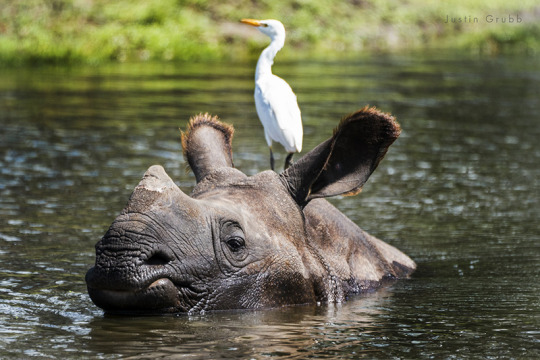
silly guy
#fortunately the Indian rhino isn't endangered#also that pic of the Sumatran rhinoceros has the brush in front of it- I thought the poor thing just had a dip#like a cartoon character getting squished in one part of their body#personal pig#chimeramoth
9 notes
·
View notes
Text
I’ve heard these guys are much more harry than their African counterparts. Possibly more closely related to ice age wooly rhinos.
Wow what a beautiful baby idiot
26K notes
·
View notes